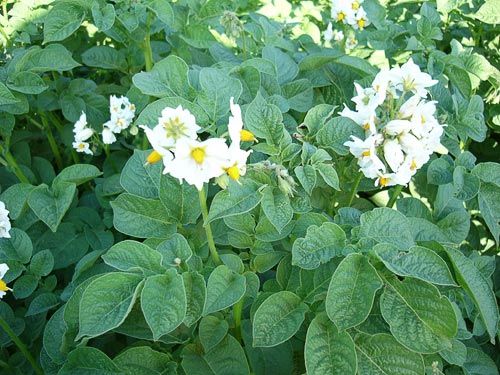So that brings me down to the actual subject: the humble potato.
What would we do without the potato? I personally would be an unhappy camper if I had to go without (though they say you can't miss what you've never had... or something like that). Without the potatoes we wouldn't have oh... potato chips (crisps), fries (chips), hash browns, potato noodles (otherwise known as glass noodles, they are made with potato flour or starch or something and they are translucent and jelly like and although they look like alien brains, they are freaking awesome in stir fries!) We wouldn't have potatoes to go with the roast beast for Christmas, or mashed potatoes to put beside the turkey at Thanksgiving, or home fries to have at breakfast on the weekends. You'd have to find something else to make that beef stew tasty, and there would be no shepherds pie without the mashed potato topping.
So, early on in the planning stages of my gardening adventures (or fiascoes) I decided that we should attempt to grow potatoes. This was encouraged by the first really big investment in gardening: the renting of two plots in the local community garden. They're each about 12x18, and they provide plenty of space for three adults to grow plenty of food for themselves throughout the spring, summer and fall. My plan was that these gardening spaces would be supplemented by what I could grow around the house, so between the three spaces, I should have plenty to store for the cold seasons.
So, if you don't know much about growing potatoes, it's pretty simple. The tuber (the part you eat) is what you plant. You leave the tuber in a dry, warm place without light to "chit" (sprout from the eyes). All potatoes, when left in our larder, will sprout, even the ones from the store, so I bought two sacks of seed potatoes (Dutch Creams and Kennebecs), and left them to chit in the kitchen. I think I had covered them with some paper just to eliminate the light, and I then let them be for a few weeks.
The potato, now, is in the same family as tomatoes, eggplants, and peppers (capsicums). They're all nightshades, so that means those who are allergic to or sensitive to nightshades should avoid them. It also means the plants are somewhat toxic (but, they are perfectly safe to throw on the compost pile.) Also, you should never eat the little fruits the potato plants bear. I dunno what they'll do to you, but if you eat them and die, I'll only say "I told ya so!" Only eat the potato part.
Now that your potatoes have little sprouts on them, you can plant them. Plant them in well turned earth (makes it easier for them to grow, and make sure it's well fertilized. Well rotted animal poo that was turned in at the end of last season should do the trick. Rake up some hills and trenches. Swear at yourself when you accidentally step in the middle of one as you work and have to rake it up again. Then, when you've got all that finished, in however many rows you want to plant in, fetch your spuds and plant them.
Now, I planted mine in the hills, and let them grow in the loose earth I had raked up. Others reckon you should plant in the trenches, and pull the dirt over the plants as they grow. Whichever way you choose, you'll still get potatoes growing. Throw your spuds in the ground and cover them up with a few inches of soil, water them, and walk away.
As they develop though, they'll start to look pretty sad, disreputable almost, as their green fades into yellow and brown. But that's okay! Because it means harvest time is nearly upon you!
When you do finally get around to harvesting your taters, don't water them for a couple days. I find that's the best, less messy way to do things, because then you're not digging in mud and getting everything gummed up. Start by pulling the plants gently but firmly, straight upward. This usually will dislodge the potatoes, and make them easy to dig up. More often than not though, you'll just pull the green bit off and will be left to dig with your hands. No worries though, it's just dirt.
Now, some people will say to use a garden fork to turn the potatoes out of the ground. Although that is an effective method that doesn't require you getting down on your knees (too often) you also greatly increase your chance of spearing the spuds, thus opening up avenues through which they can go bad, very quickly in some cases, and since most people want to store their potatoes, we'd like to avoid that.
Once you've harvested your potatoes, throw the plants on the compost, let the potatoes out in a single layer to dry in the sun for a bit, and then back into paper bags or cardboard boxes, and store in cool dry places. Don't worry about washing them; just knock the worst of the dirt off, and by "knock" I mean with the gentlest touch, to avoid bruising the tubers. Then, whenever you want them, you'll have potatoes, fresh from your garden, totally organic, UN-sprayed, UN-poisoned, and otherwise wonderfully tasty. :)
Enjoy your dirty treasures!


No comments:
Post a Comment
Please feel free to share your comments, questions and experiences.